Pyin U Lwin (Maymyo) is a city in the Mandalay Division of Central Myanmar.
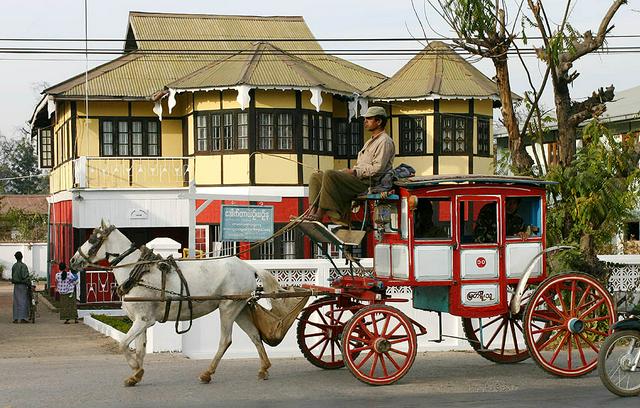 Once the summer capital of the British Raj in Burma, Pyin U Lwin retains some of the hill station look that cities like Darjeeling and Simla in India used to have in the 1960s and 1970s. Because of its history as a summer capital and a military centre of the Indian Army during British times, it has both a large Indian population and strong Anglo-Burmese and Anglo-Indian communities. As a town near the border of China, many Chinese are also settling down in this pleasant hill town. It is also an important market centre for goods from the Shan State and Kachin territories. It is home to the Defence Academy of the Burmese military, and an important military base. At an elevation of 1,070 m, there is an abundance of flowers, strawberries, and coffee beans.
Once the summer capital of the British Raj in Burma, Pyin U Lwin retains some of the hill station look that cities like Darjeeling and Simla in India used to have in the 1960s and 1970s. Because of its history as a summer capital and a military centre of the Indian Army during British times, it has both a large Indian population and strong Anglo-Burmese and Anglo-Indian communities. As a town near the border of China, many Chinese are also settling down in this pleasant hill town. It is also an important market centre for goods from the Shan State and Kachin territories. It is home to the Defence Academy of the Burmese military, and an important military base. At an elevation of 1,070 m, there is an abundance of flowers, strawberries, and coffee beans.
The British "discovered" Pyin U Lwin after the capture of Mandalay at the end of the Third Burmese War. An early Englishman wrote: "Pyin U Lwin, a charmingly situated village of some five and twenty houses, with a market-place and a gambling ring, won our hearts." (Herbert White, A Civil Servant in Burma). The British soon established a military post there and the village was renamed Maymyo (May Town) after the commander of the post, Colonel May, a veteran of the Indian Mutiny. Within a few years, after it was connected to Mandalay by rail, it became the summer residence of the British government in Burma (in the hot season, the civil service, almost to the man, would move from Rangoon to Maymyo). A little later, it was made the headquarters of the Burma Division, a largely Gurkha and Indian division, and the remnants of that division forms the core of the Nepali population of Pyin U Lwin today. White goes on to say that: "Without pretension to the picturesque, it is a place of great charm and quiet beauty, with no palm trees and few pagodas, conspicuously un-Oriental, more like a corner of Surrey than of Burma." While the Surrey analogy will seem a stretch to anyone who has visited Surrey, Pyin U Lwin still seems less like Burma than almost anywhere else in the country.
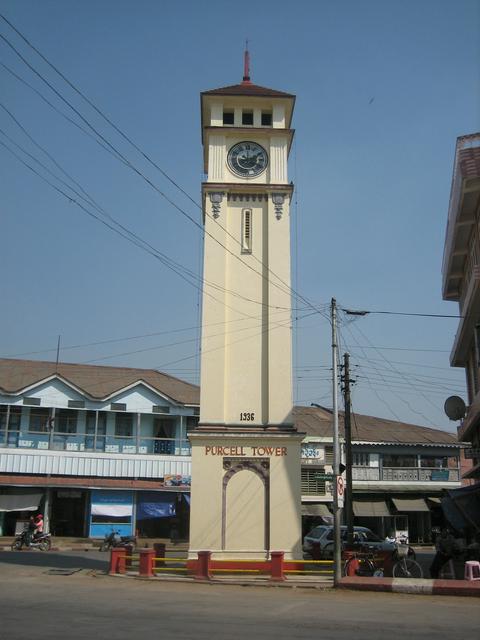
Cooler, relatively speaking, than the plains and the temperature rarely goes over 30°C in summer. Winter temperatures often fall below 10°C at night, so be prepared.
- Ellis, Beth, An English Girl's First Impression of Burmah, Bangkok, Orchid Press, 1997. First published in 1899, Beth Ellis's book is an irreverent look at the British Empire set in the hill town of Maymyo (she calls it Reymyo), Pyin U Lwin in modern times.
- Theroux, Paul, The Great Railway Bazaar: By Train Through Asia, Penguin Books, 1995. In his rail travel classic, Paul Theroux did the journey from Mandalay to Maymyo, meets the caretaker of Candacraig, and then stays in the lodge itself. His journey, set during a time when Burma was an impossibly closed country, is a lot easier today but is still recognisably the same. A recommended read.
Pyin U Lwin is relatively free of the ubiquitous pagodas. Some colonial Tudor-style houses still stand (mostly around the National Kandawgyi Gardens), albeit in poor condition, and walking around is an interesting way to see how the Raj lived. There are many churches as well, the oldest dating to about 1910.
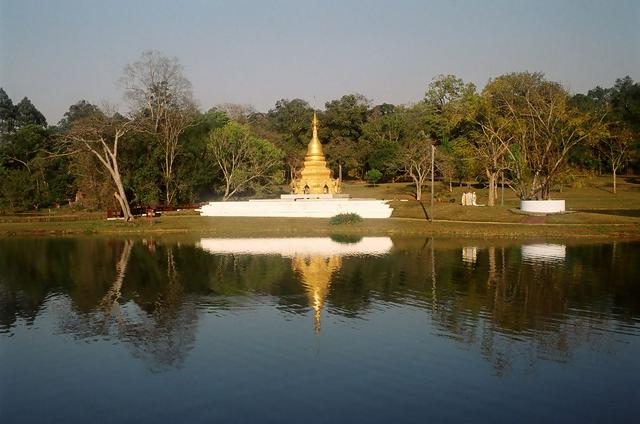
- The Candacraig. Colonial mansion built as a guest house of The Bombay Burmah Trading Corporation in 1904. Made famous by Paul Theroux in The Great Railway Bazaar, it is a good place to stop and see how the colonials lived. But, be aware that the house and hotel are now owned by the government. Other colonial houses remade into government run hotels include The Croxton and Craddock Court.
- Chinese Temple. A large and colourful Chinese temple built by the many Yunanese immigrants to the town.
- English Cemetery. The cemetery is in very poor condition having been "nationalized" by the junta and most of the headstones are in disrepair with unreadable inscriptions. Still, a few survive and will be worth the time spent if you are a history buff. St James Church, once Anglican but now Catholic, lies across the road. Drop in and see the plaques to the various British lives lost in various wars. The friendly chaplain will show you around. Take a bike or a horse carriage since the cemetery is quite far.
- National Kandawgyi Gardens. Established in 1915 by Alex Rodger as the Maymyo Botanical Gardens, the garden has a rich and diverse collection of flora, including many English plant varieties, and is without a doubt among the most beautiful botanical gardens in the world. A rose garden, a stupa in the middle of a pond and an orchid garden are among the highlights. Seeds are available for sale. A popular spot for locals. Open from 08:00 to 18:00. 6,500 kyat or US$5.
- Purcell Tower. The clock in this tower is reputed to mime the chimes of Big Ben (or so says Lonely Planet).
- Shiva Temple. Hindu temple to the god Shiva.
- National Landmarks Garden, next to botanical gardens. A grandiose collection of large models of Burma's landmarks. Generally pretty boring but has interesting touches like proudly displaying oil wells in the middle of a line of stupa. Entrance fee for foreigners is US$4 (or the kyat equivalent).
The Candacraig. Colonial mansion built as a guest house of The Bombay Burmah Trading Corporation in 1904. Made famous by Paul Theroux in The Great Railway Bazaar, it is a good place to stop and see how the colonials lived. But, be aware that the house and hotel are now owned by the government. Other colonial houses remade into government run hotels include The Croxton and Craddock Court.
Chinese Temple. A large and colourful Chinese temple built by the many Yunanese immigrants to the town.
English Cemetery. The cemetery is in very poor condition having been "nationalized" by the junta and most of the headstones are in disrepair with unreadable inscriptions. Still, a few survive and will be worth the time spent if you are a history buff. St James Church, once Anglican but now Catholic, lies across the road. Drop in and see the plaques to the various British lives lost in various wars. The friendly chaplain will show you around. Take a bike or a horse carriage since the cemetery is quite far.
National Kandawgyi Gardens. Established in 1915 by Alex Rodger as the Maymyo Botanical Gardens, the garden has a rich and diverse collection of flora, including many English plant varieties, and is without a doubt among the most beautiful botanical gardens in the world. A rose garden, a stupa in the middle of a pond and an orchid garden are among the highlights. Seeds are available for sale. A popular spot for locals. Open from 08:00 to 18:00. 6,500 kyat or US$5.
Purcell Tower. The clock in this tower is reputed to mime the chimes of Big Ben (or so says Lonely Planet).
Shiva Temple. Hindu temple to the god Shiva.
National Landmarks Garden, next to botanical gardens. A grandiose collection of large models of Burma's landmarks. Generally pretty boring but has interesting touches like proudly displaying oil wells in the middle of a line of stupa. Entrance fee for foreigners is US$4 (or the kyat equivalent).
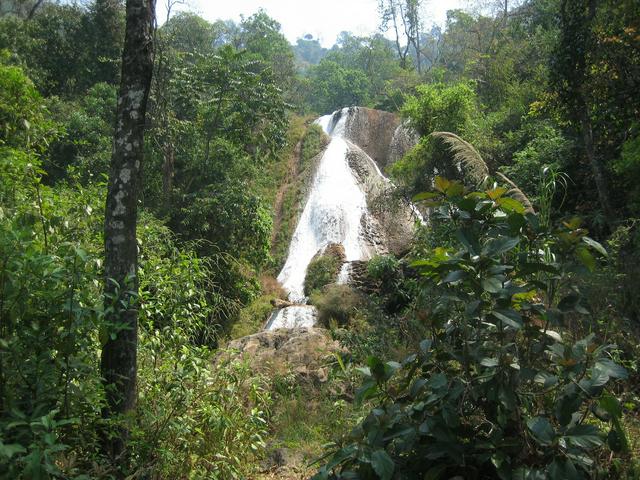
- Anisakan Falls. In a rugged gorge and framed at the base by a Buddhist temple, Anisaken Falls makes a good half day hike from Pyin U Lwin. Mandalay-bound pick-ups (300 kyat) drop you at the village of Anisakan (tell the driver you're going to the falls and he'll drop you at the road to the falls rather than in the village itself). From there, follow a long road (about 2 km) through the village, across a railway line, by a monastery, and through fields to the start of the trail. Alternatively, take a taxi from Pyin U Lwin to the trailhead and back (about US$15). It's also possible to get there by bicycle, since it's only 12 km from town centre, but it's not a very nice ride as the road is steep, with a lot of traffic. Stalls at the trail head sell water, soft drinks, and snacks. The path is very steep but short, 35-45 minutes from the trail head to the bottom of the falls. You can then return the way you came or hike up to the top of the falls on a steep trail that runs along the falls itself. If you hike up the falls, you'll notice (with heart pounding from the steep climb) that the falls are actually three falls and the view of the lowest level becomes increasingly delightful as you head up. Once on the top, it is a short walk back to the trail head. If you came by pickup, walk back to the main road and flag a Pyin U Lwin-bound pickup, there are plenty.
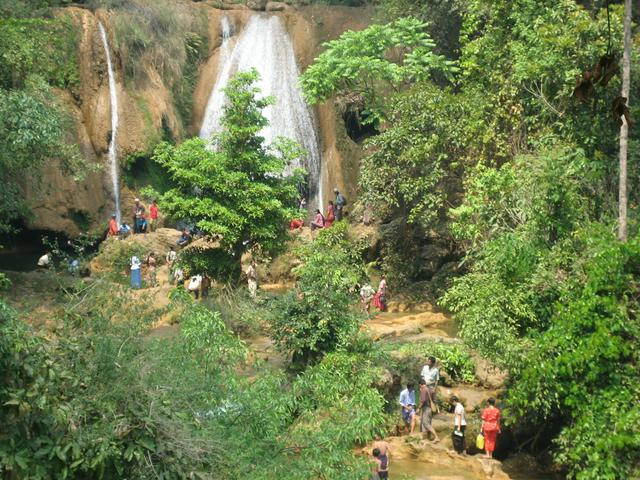
- Pwe Kauk Falls. Known as Hampshire Falls in British times. Not much to look at by the standards of falls elsewhere, but they are a popular picnic spot and seeing Burmese families picnicking and enjoying themselves is the main reason to go. A precarious bridge crosses the stream and disappears into a fig tree. The falls are on the way to Lashio so you'll need to hire a taxi but, if you want to save money, hang around long enough at the Lashio taxi stand and you'll find a share taxi (share taxis to the falls wait for you and bring you back). A one hour hike from the falls (take a guide, it is easy to get lost) gets you to the natural caves of U Naung Gu where you'll find several Buddhas.
- Pyeik Chin Miang. Further along the road to Lashio are these deep caves full of Buddhas. A large pool a little way down is a popular swimming hole. Share taxis to Pwe Kauk Falls often make the trip.
- Shan villages. If you're not planning to go on to Hsipaw or Kyaukme, you can stop by at the Shan villages of Mogyopit, Yechando and Ye Negye on your way to Pwe Kauk Falls.
- Gokteik Viaduct daytrip. You can cross the viaduct and come back the same day. Take the Lashio bound train at 08:22to Naung Paing (700/1,600 kyat ordinary/upper class), the first stop after the viaduct. You will arrive there around 11:50. Get out and take the Mandalay-bound train at 12:30. At around 10:30 the train will stop in Naung Che (Naung Hkio) for about 10 min. This is the stop just before Gokteik and your chance to buy lunch: Rice and chicken in banana leaf is sold on the platform by a couple of ladies. Make sure to tell the conductor that you want to cross the viaduct and take the train back to Pyin U Lwin. Sometimes the train delays and has to wait at Gokteik station (before crossing the viaduct) for the train from Lashio. This means you can't cross the bridge without missing your return train. They will then tell you to change the train there at Gokteik station. Although you are not able to cross the viaduct by train, you can still watch the other train doing so and best of all: you can walk on the viaduct and photograph the spectacular scenery. The local officers will guide your way and take care of your safety.
Anisakan Falls. In a rugged gorge and framed at the base by a Buddhist temple, Anisaken Falls makes a good half day hike from Pyin U Lwin. Mandalay-bound pick-ups (300 kyat) drop you at the village of Anisakan (tell the driver you're going to the falls and he'll drop you at the road to the falls rather than in the village itself). From there, follow a long road (about 2 km) through the village, across a railway line, by a monastery, and through fields to the start of the trail. Alternatively, take a taxi from Pyin U Lwin to the trailhead and back (about US$15). It's also possible to get there by bicycle, since it's only 12 km from town centre, but it's not a very nice ride as the road is steep, with a lot of traffic. Stalls at the trail head sell water, soft drinks, and snacks. The path is very steep but short, 35-45 minutes from the trail head to the bottom of the falls. You can then return the way you came or hike up to the top of the falls on a steep trail that runs along the falls itself. If you hike up the falls, you'll notice (with heart pounding from the steep climb) that the falls are actually three falls and the view of the lowest level becomes increasingly delightful as you head up. Once on the top, it is a short walk back to the trail head. If you came by pickup, walk back to the main road and flag a Pyin U Lwin-bound pickup, there are plenty.
Pwe Kauk Falls. Known as Hampshire Falls in British times. Not much to look at by the standards of falls elsewhere, but they are a popular picnic spot and seeing Burmese families picnicking and enjoying themselves is the main reason to go. A precarious bridge crosses the stream and disappears into a fig tree. The falls are on the way to Lashio so you'll need to hire a taxi but, if you want to save money, hang around long enough at the Lashio taxi stand and you'll find a share taxi (share taxis to the falls wait for you and bring you back). A one hour hike from the falls (take a guide, it is easy to get lost) gets you to the natural caves of U Naung Gu where you'll find several Buddhas.
Pyeik Chin Miang. Further along the road to Lashio are these deep caves full of Buddhas. A large pool a little way down is a popular swimming hole. Share taxis to Pwe Kauk Falls often make the trip.
Shan villages. If you're not planning to go on to [[Hsipaw]] or [[Kyaukme]], you can stop by at the Shan villages of Mogyopit, Yechando and Ye Negye on your way to Pwe Kauk Falls.
Gokteik Viaduct daytrip. You can cross the viaduct and come back the same day. Take the Lashio bound train at 08:22to Naung Paing (700/1,600 kyat ordinary/upper class), the first stop after the viaduct. You will arrive there around 11:50. Get out and take the Mandalay-bound train at 12:30. At around 10:30 the train will stop in Naung Che (Naung Hkio) for about 10 min. This is the stop just before Gokteik and your chance to buy lunch: Rice and chicken in banana leaf is sold on the platform by a couple of ladies. Make sure to tell the conductor that you want to cross the viaduct and take the train back to Pyin U Lwin. Sometimes the train delays and has to wait at Gokteik station (before crossing the viaduct) for the train from Lashio. This means you can't cross the bridge without missing your return train. They will then tell you to change the train there at Gokteik station. Although you are not able to cross the viaduct by train, you can still watch the other train doing so and best of all: you can walk on the viaduct and photograph the spectacular scenery. The local officers will guide your way and take care of your safety.
Pyin U Lwin is famous, in Myanmar that is, for strawberries, coffee, flowers, sweaters and damsons. The market is full of shops selling these products. In spring (late Feb, early Mar), flower stalls line the road to Mandalay. The Golden Triangle Cafe and Bakery sells organic coffee from local plantations (ground and whole beans, all vacuum packed). Strawberry jam is readily available (it'll show up in your breakfast). And many stores around the clock tower sell sweaters, the speciality of all old British hill stations everywhere.
Pyin U Lwin has quite a few Indian sweet shops with the usual complement of Indian sweets (barfi, laddoo, gulab jamun, etc.). If you have a sweet tooth, this is the place to indulge it. There are several shops close to the Mandalay pick-up stand (on Lashio Rd by the Clock Tower), and at least one near the Central Market.
- Aung Padamya Restaurant. closes at 21:00. This is possibly the best Indian restaurant in all of Myanmar.
- Golden Triangle Cafe and Bakery. An American-run cafe and bakery. This is one of the few places in Myanmar where you can get a decent espresso (1,800 kyat). Pizzas, burgers (mutton and veggie), sandwiches. Try their milk shakes and fresh fruit juices.
- Krishna Restaurant, House 50, Block 5, Gorakha Rd (In a lane behind Grace Hotel II, parallel to Mandalay-Lashio Rd. An unmarked Indian restaurant serving Indian curries with lentils, chapatis and rice. Well-priced, good home cooked food.
- South Indian Food Centre. A depressing looking family establishment that nevertheless does amazing thali-style curry meals at low prices. There are numerous small, cheap Indian restaurants around town that also do similar meals. Meals for US$2.
- the restaurant with no English name, Ziwaka street (from Mandalay-Lashio road walk south at roundabout on Ziwaka street. After passing 3 streets on the left, look for a restaurant that has a big tree in front of entrance with small shrine attached to tree. Located before Ziwaka street branches into 3 roads. Round the corner from Grace 1 Hotel and San Francisco Restaurant.. This restaurant has no English sign or transcripted Burmese name. But it does have an English menu! Go for a traditional set Burmese menu and choose any of their delicious curries. The curry is accompanied by 8 side dishes, 1 massive veggy plate with dressing, a soup, rice and a bowl of more rice to go for seconds or thirds. Plates are refilled by the attentive staff for no extra charge when empty. Meals from 2,500 kyat.
Aung Padamya Restaurant. closes at 21:00. This is possibly the best Indian restaurant in all of Myanmar.
Golden Triangle Cafe and Bakery. An American-run cafe and bakery. This is one of the few places in Myanmar where you can get a decent espresso (1,800 kyat). Pizzas, burgers (mutton and veggie), sandwiches. Try their milk shakes and fresh fruit juices.
Krishna Restaurant, House 50, Block 5, Gorakha Rd (In a lane behind Grace Hotel II, parallel to Mandalay-Lashio Rd. An unmarked Indian restaurant serving Indian curries with lentils, chapatis and rice. Well-priced, good home cooked food.
South Indian Food Centre. A depressing looking family establishment that nevertheless does amazing thali-style curry meals at low prices. There are numerous small, cheap Indian restaurants around town that also do similar meals. Meals for US$2.
the restaurant with no English name, Ziwaka street (from Mandalay-Lashio road walk south at roundabout on Ziwaka street. After passing 3 streets on the left, look for a restaurant that has a big tree in front of entrance with small shrine attached to tree. Located before Ziwaka street branches into 3 roads. Round the corner from Grace 1 Hotel and San Francisco Restaurant.. This restaurant has no English sign or transcripted Burmese name. But it does have an English menu! Go for a traditional set Burmese menu and choose any of their delicious curries. The curry is accompanied by 8 side dishes, 1 massive veggy plate with dressing, a soup, rice and a bowl of more rice to go for seconds or thirds. Plates are refilled by the attentive staff for no extra charge when empty. Meals from 2,500 kyat.
- A local grape wine is available in addition to the various beers. A bit sweet for Western palates, but worth a try.
- Pyin U Lwin is the centre for coffee plantations in Burma.
For some reason, international calls are cheaper in Pyin U Lwin and you can call overseas to the UK and U.S. for about US$3-4 a minute by shopping around. Try the call office just before the cinema on the road from Grace Hotel I to the clock tower.
- There are a few Internet cafes in the city. One is T.Net around the corner from the Golden Triangle Bakery, 400 kyat/hour. Another is on the first street to the right after the bakery, Day and Night Internet.
- Gokteik - the Gokteik Viaduct, a famous bridge, a marvel of British ingenuity and American engineering, is a couple of hours away by train. Most tourists stay on the train to see it and head for Hsipaw and/or Lashio, but it is also possible (and well-worth the time) to make the trip there and back in a day. Train leaves Pyin U Lwin at 08:30.
- Hsipaw - laid back Shan town a few hours to the northeast, and a good place for trips to Shan and Palaung villages.
- Kyauk Me - a Shan town that is much less touristy than Hsipaw, also a good base for trekking in Shan and Palaung villages.
[[Gokteik]] - the Gokteik Viaduct, a famous bridge, a marvel of British ingenuity and American engineering, is a couple of hours away by train. Most tourists stay on the train to see it and head for [[Hsipaw]] and/or [[Lashio]], but it is also possible (and well-worth the time) to make the trip there and back in a day. Train leaves Pyin U Lwin at 08:30.
